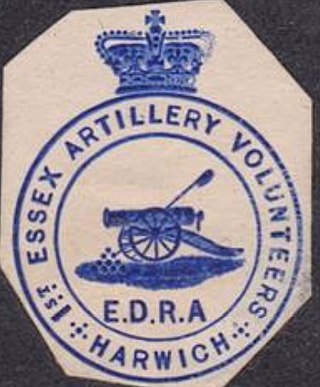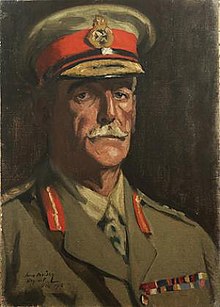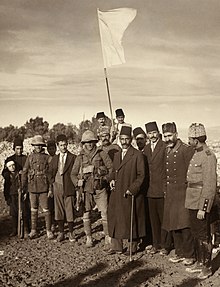
The 11th (Northern) Division, was an infantry division of the British Army during the First World War, raised from men who had volunteered for Lord Kitchener's New Armies. The division fought in the Gallipoli Campaign and on the Western Front. The division's insignia was an ankh or ankhus.

The 31st Division was an infantry division of the British Army. It was raised in the Great War by volunteers from Kitchener's Army and formed in April 1915 as part of the K4 Army Group and taken over by the War Office on 10 August 1915. Comprising mainly infantry battalions from Yorkshire and Lancashire, the division was sent to Egypt in December 1915 before moving to France in March 1916 and spent the remainder of the First World War in action on the Western Front. The 31st Division was the quintessential New Army division, being made up entirely of Pals battalions.

The 46th Division was an infantry division of the British Army, part of the Territorial Force, that saw service in the First World War. At the outbreak of the war, the 46th Division was commanded by Major-General Hon. E.J. Montagu-Stuart-Wortley. Originally called the North Midland Division, it was redesignated as the 46th Division in May 1915.
XLIV (Howitzer) Brigade, Royal Field Artillery was a brigade of the Royal Field Artillery which served in the First World War. It joined the BEF in August 1914 before being broken up in May 1916. It was reformed as XLIV Brigade, Royal Field Artillery in early 1917, serving in Palestine and the Western Front before being disbanded after the end of the war.

The 59th Division was an infantry division of the British Army during World War I. It was formed in late 1914/early 1915 as a 2nd Line Territorial Force formation raised as a duplicate of the 46th Division. After training in the United Kingdom and seeing service in the Easter Rising in April 1916, the division joined the British Expeditionary Force (BEF) on the Western Front in early 1917. It saw action at Ypres and Cambrai, and was almost destroyed during the German Army's Spring Offensive in March 1918. The reconstituted division took part in the final advances of the war.
71st Division was a short-lived infantry division of the British Army during the First World War. It served in the Home Defence forces and never went overseas.
73rd Division was a short-lived infantry division of the British Army during World War I. It served in Home Forces and never went overseas.
The Berkshire Royal Horse Artillery was a Territorial Force Royal Horse Artillery battery that was formed in Berkshire in 1908. It saw active service during the First World War in the Middle East, notably at Aden and in particular in the Sinai and Palestine Campaign, from 1915 to 1918. A second line battery, 2/1st Berkshire RHA, served on the Western Front in 1917 and 1918 as part of an Army Field Artillery Brigade. After the Armistice, it was reconstituted as a Royal Field Artillery battery of the Territorial Army (TA), later being expanded into a full heavy anti-aircraft (HAA) regiment that served during the Second World War in the Battle of Britain and Blitz, in the assault landings in North Africa, Sicily and Italy. Postwar, it continued in the TA until 1968.
The 2nd Home Counties Division was a 2nd Line Territorial Force division of the British Army in World War I. The division was formed as a duplicate of the 44th Division in November 1914. As the name suggests, the division recruited in the Home Counties, particularly Kent, Middlesex, Surrey and Sussex. In August 1915, in common with all Territorial Force divisions, it was numbered as 67th Division. Between September 1917 and the end of the year, the division was extensively reorganized and lost its territorial identity; henceforth it was known as 67th Division.

The 1st Lincolnshire Artillery Volunteers were formed in 1860 as a response to a French invasion threat. They fought on the Western Front during World War I. In World War II, the unit took part in the Battle of France and Dunkirk evacuation, the Anglo-Iraqi War with 'Kingcol', the Western Desert Campaign in which it distinguished itself at the Battle of Sidi Rezegh, and finally fought as infantry in the Chindits. The unit was disbanded in 1947.
The 1st Lanarkshire Artillery Volunteers were formed in 1859 as a response to a French invasion threat. Its units fought at Gallipoli and in Palestine during World War I, and in Normandy and North West Europe during World War II. It continued in the postwar Territorial Army until 1961.

The Metropolitan Artillery Volunteers was a part-time unit of the British Volunteer Force formed in the London area in 1861. It was designated the 3rd Middlesex Artillery Volunteers and went on to become the 5th London Brigade, Royal Field Artillery in the Territorial Force. It provided two active service units in the First World War, which saw action on the Western Front. Just before the Second World War it again spun off a duplicate regiment, each taking the '5th London' subtitle. Both regiments saw widely varied service during the war. The regiment later provided an airborne artillery unit in the Territorial Army of the 1950s.

The 1st Essex Artillery Volunteers was a unit of Britain's part-time auxiliary forces raised in Essex in 1860 in response to an invasion scare. It served under various designations as field artillery in Palestine during World War I. During World War II its units served as mountain artillery in Italy and as jungle artillery and medium artillery in Burma. Postwar it became an airborne unit until it was merged with other units in the 1950s.
The Cheshire Artillery Volunteers was a brigade of Volunteer artillery units raised in the county of Cheshire in the mid-19th century. Their successors served as field artillery in Palestine during World War I and as anti-aircraft (AA) gunners in the Middle East in World War II. They continued in the air defence role in the Territorial Army until 1955.

The IV (4th) Lowland (Howitzer) Brigade, Royal Field Artillery was a new unit formed when Britain's Territorial Force was created in 1908. Its origins lay in the 1st Lanarkshire Artillery Volunteers formed in Glasgow, Scotland, in the 1860s. During World War I the brigade served at Gallipoli and in Egypt. It was broken up in 1916, but its individual batteries served on with other Scottish artillery units for the rest of the war and into World War II.

The 6th County of London Brigade, Royal Field Artillery was a new unit formed when Britain's Territorial Force was created in 1908. Its origin lay in Artillery Volunteer Corps formed in the Surrey suburbs of South London in the 1860s, which had later been incorporated into a larger London unit. Together with its wartime duplicate it served on the Western Front, at Salonika and in Palestine during the First World War. Converted to the anti-tank role just before the Second World War it saw widely varied service during the war, while its duplicate regiment landed on D-Day. The regiment continued in the postwar Territorial Army until 1961.

The 7th London Brigade, Royal Field Artillery was a new unit formed when Britain's Territorial Force was created in 1908. Its origin lay in Artillery Volunteer Corps formed in West London in the 1860s, which had later been incorporated into a larger London unit. Together with its wartime duplicate it served on the Western Front, at Salonika and in Palestine during the First World War. It formed several units for service in the Second World War, when they were in action in North Africa, Italy and North West Europe. The unit continued in the postwar Territorial Army until 1961.

The 8th London (Howitzer) Brigade, Royal Field Artillery was a new unit formed when Britain's Territorial Force was created in 1908. Its origin lay in Artillery Volunteer Corps formed in the 1860s in Plumstead, Kent, later incorporated into London. Together with its wartime duplicate the brigade served during the First World War on the Western Front, at Salonika and in Palestine where it was the first British unit to enter Jerusalem. It again formed two units for service in the Second World War, one of which saw extensive action in France, North Africa, and Italy, while its duplicate was captured at the Fall of Singapore. Its successor unit continues in the Army Reserve today.
The 1st Worcestershire Artillery Volunteers was a part-time unit of Britain's Royal Artillery dating back to 1865. As part of the Territorial Force it served on the Western Front and in Italy during World War I. In World War II it served in the Battle of France and was evacuated from Dunkirk. It later fought in Tunisia and Italy. After a series of postwar mergers, it continues as a battery in today's British Army Reserve.

The IV South Midland Brigade of the Royal Field Artillery (RFA) was a unit of Britain's Territorial Force (TF) from 1908 to 1919. Recruited from Warwickshire, it served on the Western Front during World War I, when it was broken up to reinforce other units.












